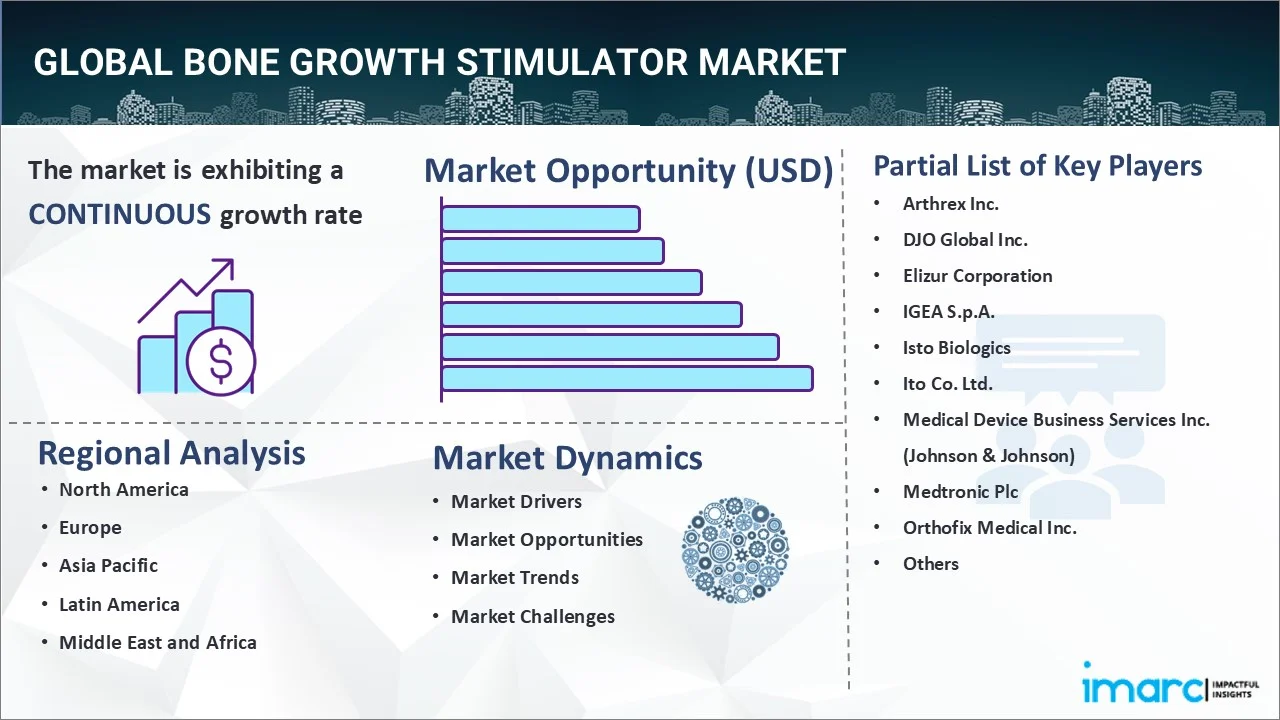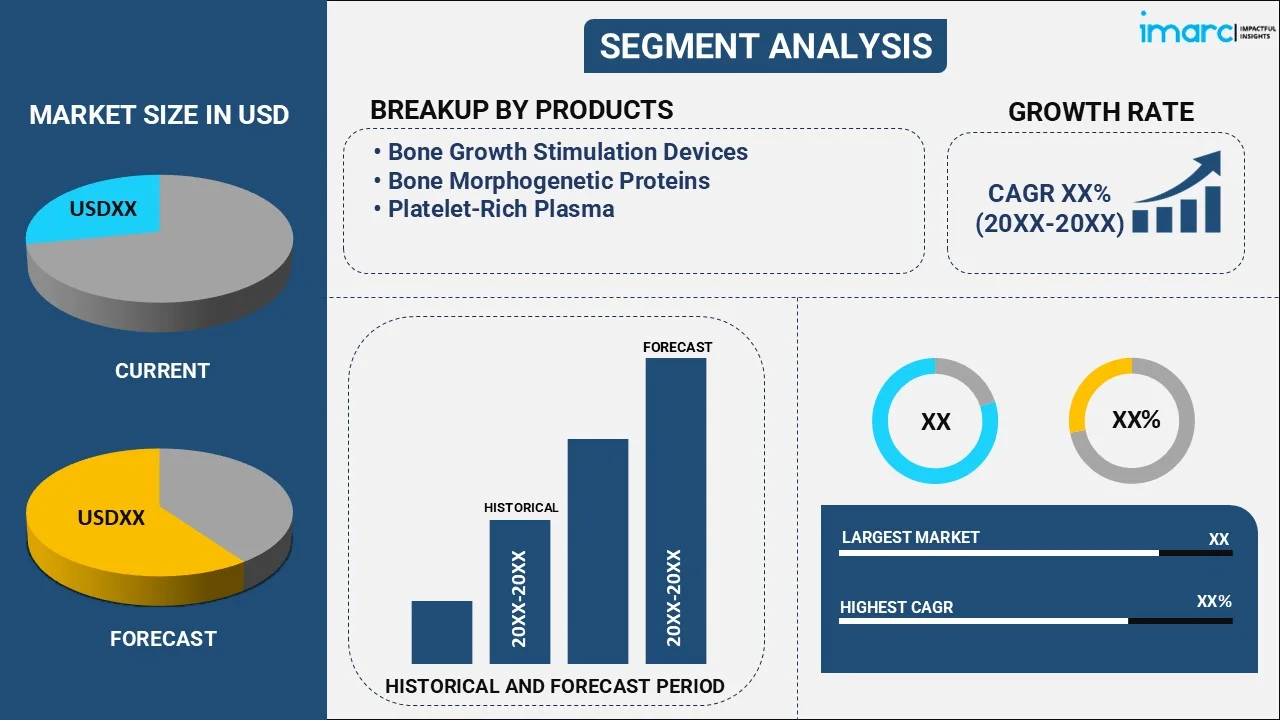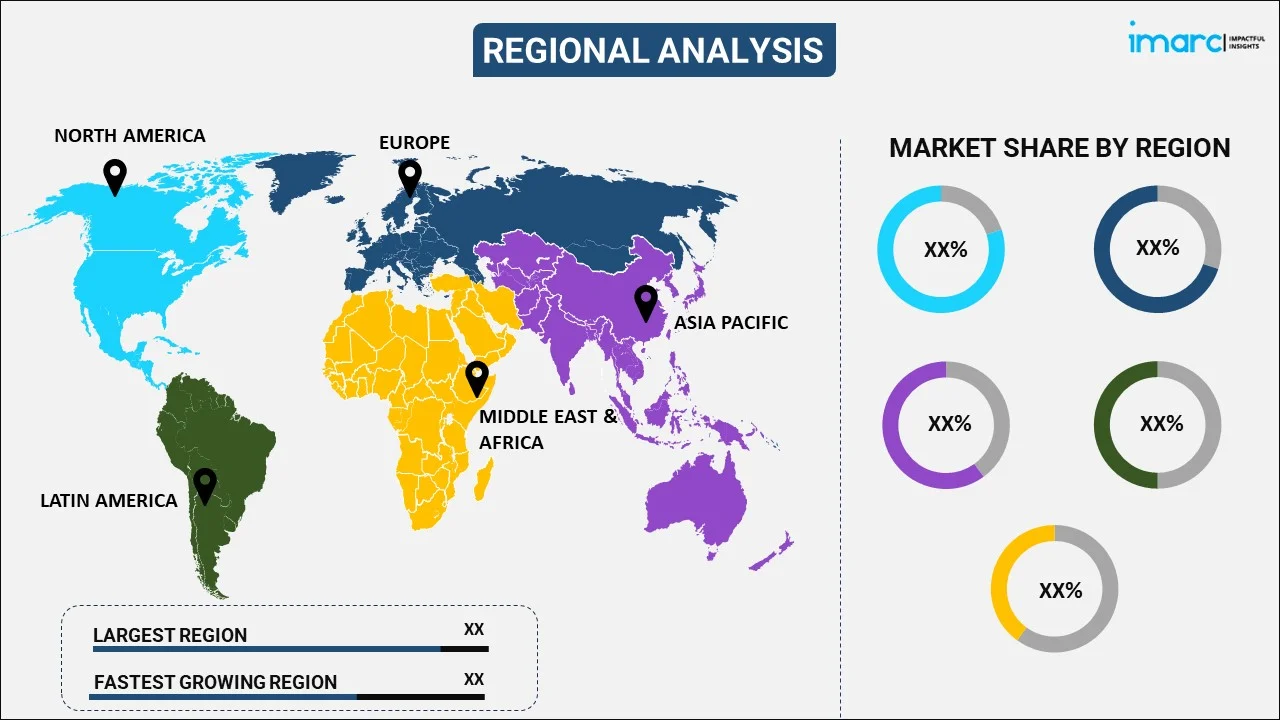
Bone Growth Stimulator Market Report by Product (Bone Growth Stimulation Devices, Bone Morphogenetic Proteins, Platelet-Rich Plasma), Application (Spinal Fusion Surgeries, Delayed Union and Nonunion Bone Fractures, Oral and Maxillofacial Surgeries, and Others), End User (Hospitals and Clinics, Home Care, and Others), and Region 2025-2033
Bone Growth Stimulator Market Size:
The global bone growth stimulator market size reached USD 2.2 Billion in 2024. Looking forward, IMARC Group expects the market to reach USD 3.4 Billion by 2033, exhibiting a growth rate (CAGR) of 4.8% during 2025-2033. The market is experiencing stable growth driven by the growing incidences of bone fractures due to accidents, sports injuries, and age-related factors, rising development of user-friendly devices, and increasing preferences for non-invasive treatment solutions.
|
Report Attribute
|
Key Statistics
|
|---|---|
|
Base Year
|
2024
|
|
Forecast Years
|
2025-2033
|
|
Historical Years
|
2019-2024
|
|
Market Size in 2024
|
USD 2.2 Billion |
|
Market Forecast in 2033
|
USD 3.4 Billion |
| Market Growth Rate 2025-2033 | 4.8% |
Bone Growth Stimulator Market Analysis:
- Major Market Drivers: According to the bone growth stimulator market outlook, key drivers include the rising sports-related injuries, awareness about the benefits of accelerated bone healing and reduced recovery time, and rapid technological advancements, such as the development of electromagnetic and ultrasound-based stimulators.
- Key Market Trends: Based on the bone growth stimulator market statistics, notable trends include the ongoing shift towards non-invasive treatments, growing demand for portable, user-friendly devices, and ongoing advancements in regenerative medicine.
- Geographical Trends: North America leads the market, driven by the presence of well-established healthcare infrastructure. However, Asia Pacific is emerging as a fast-growing market due to the increasing focus on enhanced treatment solutions among patients.
- Competitive Landscape: Some of the major market players in the bone growth stimulator industry include Arthrex Inc., DJO Global Inc., Elizur Corporation, IGEA S.p.A., Isto Biologics, Ito Co. Ltd., Medical Device Business Services Inc. (Johnson & Johnson), Medtronic Plc, Orthofix Medical Inc., Ossatec Benelux B.V., Stryker Corporation, Terumo Bct Inc. (Terumo Corporation), and Zimmer Biomet, among many others.
- Challenges and Opportunities: As per the bone growth stimulator market overview, the market faces challenges, such as the need for continuous research validation. It also encounters opportunities in developing more advanced and cost-effective devices.

Bone Growth Stimulator Market Trends:
Rising incidences of bone fractures
The growing adoption of bone growth stimulators due to rising incidences of bone fractures among individuals is positively impacting the uses of bone growth stimulator. In line with this, bone fractures can occur due to various reasons, such as accidents, sports injuries, and age-related factors. According to the World Health Organization (WHO), between 20 and 50 million people suffer non-fatal injuries in road accidents, leading to fracturs and injuries that require effective treatment options. Moreover, the rising employment of bone growth stimulators among the geriatric population, as they are more prone to fracture issues due to reduced bone density, is propelling the growth of the market. Apart from this, bone growth stimulators offer a viable solution for quicker and more effective bone healing, making them a preferred choice among healthcare professionals and patients. In addition, the increasing focus on enhanced treatment solutions among patients is impelling the bone growth stimulator market opportunities. Furthermore, people are increasingly preferring bone growth stimulators, as they assist in faster recovery and reduced pain as compared to traditional fracture treatments.
Technological advancements
Technological advancements assist in the development of more advanced, efficient, and user-friendly devices, which is contributing to the market growth. In addition, the increasing use of bone growth stimulators that incorporate advanced technologies, such as electromagnetic fields, ultrasound, and pulsed electromagnetic fields (PEMF), to stimulate bone regeneration, is favoring the market growth. Apart from this, improved device design and functionality not only enhance treatment outcomes but also improve patient compliance. Furthermore, the rising adoption of smaller and portable devices with advanced control, as they allow patients to incorporate them into their daily routines, is supporting the bone growth simulator market share. In line with this, healthcare providers are seeking effective and evidence-based solutions for their patients. Additionally, the increasing demand for more effective and appealing treatment options among the masses is propelling the market growth. Moreover, the introduction of advanced bone growth stimulators that are equipped with wireless connectivity, enables healthcare providers to monitor patient compliance and treatment progress remotely. For instance, Orthofix Medical Inc announced U.S. FDA approval of mobile app version 2.1 STIMonTrack to advance bone growth stimulators.
Increasing preferences for non-invasive treatment solutions
The increasing demand for non-invasive and painless treatment options among patients is positively impelling the bone growth stimulator market revenue. In line with this, patients are increasingly seeking alternatives to surgery and invasive procedures. Additionally, bone growth stimulators provide a non-surgical option for bone healing. Furthermore, non-invasive treatments not only reduce patient discomfort but also minimize the risk of complications and infection. This makes bone growth stimulators particularly appealing to a broad spectrum of patients, including those who are hesitant about surgery or have contraindications for invasive procedures. Apart from this, non-invasive treatments often lead to shorter recovery times, allowing patients to resume their daily activities more quickly. Moreover, the rising focus on patient-centric approaches is bolstering the market growth. In addition, non-invasive treatments are more cost-effective as compared to surgical procedures, as they require fewer hospital resources, shorter hospital stays, and reduce overall healthcare expenses, which is positively influencing the bone growth stimulator market price.
Bone Growth Stimulator Market Segmentation:
IMARC Group provides an analysis of the key trends in each segment of the market, along with forecasts at the global, regional, and country levels for 2025-2033. Our report has categorized the market based on product, application, and end user.
Breakup by Product:

- Bone Growth Stimulation Devices
- Bone Morphogenetic Proteins
- Platelet-Rich Plasma
Bone growth stimulation devices accounts for the majority of the market share
The report has provided a detailed breakup and analysis of the market based on the product. This includes bone growth stimulation devices, bone morphogenetic proteins, and platelet-rich plasma. According to the report, bone growth stimulation devices represented the largest segment.
According to the bone growth stimulator market segment based on the product, bone growth stimulation devices hold the largest share. They are non-invasive medical instruments designed to promote the natural healing of bones. They work by delivering specific types of energy, such as electromagnetic fields, ultrasound waves, or electrical currents, to the site of the bone injury or fracture. In line with this, these devices are usually available in various forms, such as wearable braces, portable units, or implantable options. The choice of device depends on the nature and location of the fracture. They accelerate the production of bone-forming cells, such as osteoblasts, aiding in the repair and regeneration of damaged bone tissues.
Breakup by Application:
- Spinal Fusion Surgeries
- Delayed Union and Nonunion Bone Fractures
- Oral and Maxillofacial Surgeries
- Others
Spinal fusion surgeries hold the largest share of the industry
A detailed breakup and analysis of the market based on the application have also been provided in the report. This includes spinal fusion surgeries, delayed union and nonunion bone fractures, oral and maxillofacial surgeries, and others. According to the report, spinal fusion surgeries accounted for the largest market share.
According to the bone growth stimulator market trends, spinal fusion surgeries represented the largest market share. They involve joining two or more vertebrae in the spine to treat conditions like spinal instability, degenerative disc disease, or spinal fractures. In spinal fusion, bone growth stimulators play a critical role in promoting the fusion process. They stimulate bone healing at the surgical site, helping the vertebrae to fuse together more effectively and securely. The growing number of spinal-related conditions, along with the rising need for improved surgical outcomes, is positively impacting the future of bone growth stimulators.
Breakup by End User:
- Hospitals and Clinics
- Home Care
- Others
Hospitals and clinics represent the leading market segment
The report has provided a detailed breakup and analysis of the market based on the end user. This includes hospitals and clinics, home care, and others. According to the report, hospitals and clinics represented the largest segment.
As per the bone growth stimulator market segments, hospitals and clinics often use bone growth stimulators in various applications, including orthopedic surgeries, fracture management, and post-operative care. In hospitals, these stimulators are employed by orthopedic surgeons and in physical therapy departments to aid in the healing of bone fractures, spinal fusion procedures, and other orthopedic conditions. The institutional setting of hospitals and clinics ensures that patients receive expert care and guidance during the use of bone growth stimulators.
Breakup by Region:

- North America
- United States
- Canada
- Asia Pacific
- China
- Japan
- India
- South Korea
- Australia
- Indonesia
- Others
- Europe
- Germany
- France
- United Kingdom
- Italy
- Spain
- Russia
- Others
- Latin America
- Brazil
- Mexico
- Others
- Middle East and Africa
North America leads the market, accounting for the largest bone growth stimulator market share
The report has also provided a comprehensive analysis of all the major regional markets, which include North America (the United States and Canada); Europe (Germany, France, the United Kingdom, Italy, Spain, Russia, and others); Asia Pacific (China, Japan, India, South Korea, Australia, Indonesia, and others); Latin America (Brazil, Mexico, and others); and the Middle East and Africa. According to the report, North America represents the largest regional market for bone growth stimulator.
According to the bone growth stimulator market trends, North America accounted for the largest market share due to the presence of well-established healthcare infrastructure, such as hospitals and clinics. In line with this, key players are developing advanced bone growth stimulator devices, which are bolstering the growth of the market in the region. Moreover, stringent regulatory frameworks for medical devices to ensure enhanced safety and efficacy are propelling the market growth.
Competitive Landscape:
- The market research report has also provided a comprehensive analysis of the competitive landscape in the market. Detailed profiles of all major companies have also been provided. Some of the major market players in the bone growth stimulator industry include Arthrex Inc., DJO Global Inc., Elizur Corporation, IGEA S.p.A., Isto Biologics, Ito Co. Ltd., Medical Device Business Services Inc. (Johnson & Johnson), Medtronic Plc, Orthofix Medical Inc., Ossatec Benelux B.V., Stryker Corporation, Terumo Bct Inc. (Terumo Corporation), Zimmer Biomet, etc.
(Please note that this is only a partial list of the key players, and the complete list is provided in the report.)
- Recent reports analyzing how big is the bone growth stimulator market highlighted that key players in the industry are focusing on developing advanced bone growth stimulator devices by incorporating advanced technologies, improving device design, and enhancing treatment efficacy. In line with this, companies are conducting clinical trials to demonstrate the safety and effectiveness of their products. Moreover, they are expanding their product portfolios to offer a range of bone growth stimulator options, such as devices tailored as per specific applications, including spinal fusion or fracture healing, positively impacting the bone growth stimulator market price. Apart from this, manufacturers are collaborating with healthcare institutions, research organizations, and academic institutions to facilitate research, development, and the validation of bone growth stimulator technologies. Furthermore, they are working closely with regulatory authorities to obtain approvals and certifications for their devices.
Bone Growth Stimulator Market News:
- February 13, 2020: Orthofix Medical Inc., a global medical device company focused on musculoskeletal products and therapies, announced that the U.S. Food and Drug Administration (FDA) approved the use of STIM onTrack mobile app version 2.1 with the bone growth stimulators of the company. The mobile device app is an accessory designed to help patients adhere to their prescriptions and improve their clinical outcomes.
- January 8, 2020: Medtronic Plc acquired Stimgenics, LLC, a privately-held company based in Bloomington, Illinois, that has pioneered a novel spinal cord stimulation (SCS) waveform known as Differential Target Multiplexed (DTM™) spinal cord stimulation. The therapy, which is delivered via the Medtronic Intellis platform, is a new and unique programming option to treat patients with chronic pain.
- May 17, 2021: IGEA S.p.A. signed an exclusive license agreement with Orthofix Medical Inc. to commercialize overseas the range of innovative products dedicated to stimulation. In addition, the bone growth stimulation and joint preservation devices will be commercialized in the United States and Canada.
Bone Growth Stimulator Market Report Scope:
| Report Features | Details |
|---|---|
| Base Year of the Analysis | 2024 |
| Historical Period | 2019-2024 |
| Forecast Period | 2025-2033 |
| Units | Billion USD |
| Scope of the Report | Exploration of Historical Trends and Market Outlook, Industry Catalysts and Challenges, Segment-Wise Historical and Future Market Assessment:
|
| Products Covered | Bone Growth Stimulation Devices, Bone Morphogenetic Proteins, Platelet-Rich Plasma |
| Applications Covered | Spinal Fusion Surgeries, Delayed Union and Nonunion Bone Fractures, Oral and Maxillofacial Surgeries, Others |
| End Users Covered | Hospitals and Clinics, Home Care, Others |
| Regions Covered | Asia Pacific, Europe, North America, Latin America, Middle East and Africa |
| Countries Covered | United States, Canada, Germany, France, United Kingdom, Italy, Spain, Russia, China, Japan, India, South Korea, Australia, Indonesia, Brazil, Mexico |
| Companies Covered | Arthrex Inc., DJO Global Inc., Elizur Corporation, IGEA S.p.A., Isto Biologics, Ito Co. Ltd., Medical Device Business Services Inc. (Johnson & Johnson), Medtronic Plc, Orthofix Medical Inc., Ossatec Benelux B.V., Stryker Corporation, Terumo Bct Inc. (Terumo Corporation), Zimmer Biomet, etc. |
| Customization Scope | 10% Free Customization |
| Post-Sale Analyst Support | 10-12 Weeks |
| Delivery Format | PDF and Excel through Email (We can also provide the editable version of the report in PPT/Word format on special request) |
Key Benefits for Stakeholders:
- IMARC’s industry report offers a comprehensive quantitative analysis of various market segments, historical and current market trends, market forecasts, and dynamics of the bone growth stimulator market from 2019-2033.
- The research report provides the latest information on the market drivers, challenges, and opportunities in the global bone growth stimulator market.
- The study maps the leading, as well as the fastest-growing, regional markets. It further enables stakeholders to identify the key country-level markets within each region.
- Porter's five forces analysis assists stakeholders in assessing the impact of new entrants, competitive rivalry, supplier power, buyer power, and the threat of substitution. It helps stakeholders to analyze the level of competition within the bone growth stimulator industry and its attractiveness.
- The competitive landscape allows stakeholders to understand their competitive environment and provides insight into the current positions of key players in the market.
Key Questions Answered in This Report
The bone growth stimulator market was valued at USD 2.2 Billion in 2024.
We expect the global bone growth stimulator market to exhibit a CAGR of 4.8% during 2025-2033.
The rising demand for Minimally Invasive (MI) procedures, along with the increasing adoption of bone growth stimulators to enhance blood flow to the affected area, increase cellular activity, and promote the formation of new bone tissue, is primarily driving the global bone growth stimulator market.
The sudden outbreak of the COVID-19 pandemic had led to the postponement of elective surgical procedures to reduce the risk of the coronavirus infection upon hospital visits and interaction with medical equipment, thereby negatively impacting the global market for bone growth stimulator.
Based on the product, the global bone growth stimulator market can be divided into bone growth stimulation devices, bone morphogenetic proteins, and platelet-rich plasma. Currently, bone growth stimulation devices hold the largest market share.
Based on the application, the global bone growth stimulator market has been categorized into spinal fusion surgeries, delayed union and nonunion bone fractures, oral and maxillofacial surgeries, and others. Among these, spinal fusion surgeries currently account for the majority of the global market share.
Based on the end user, the global bone growth stimulator market can be bifurcated into hospitals and clinics, home care, and others. Currently, hospitals and clinics exhibit a clear dominance in the market.
On a regional level, the market has been classified into North America, Asia-Pacific, Europe, Latin America, and Middle East and Africa, where North America currently dominates the global market.
Some of the major players in the global bone growth stimulator market include Arthrex Inc., DJO Global Inc., Elizur Corporation, IGEA S.p.A., Isto Biologics, Ito Co. Ltd., Medical Device Business Services Inc. (Johnson & Johnson), Medtronic Plc, Orthofix Medical Inc., Ossatec Benelux B.V., Stryker Corporation, Terumo Bct Inc. (Terumo Corporation), and Zimmer Biomet.
Need more help?
- Speak to our experienced analysts for insights on the current market scenarios.
- Include additional segments and countries to customize the report as per your requirement.
- Gain an unparalleled competitive advantage in your domain by understanding how to utilize the report and positively impacting your operations and revenue.
- For further assistance, please connect with our analysts.
 Inquire Before Buying
Inquire Before Buying
 Speak to an Analyst
Speak to an Analyst
 Request Brochure
Request Brochure
 Request Customization
Request Customization




.webp)




.webp)












